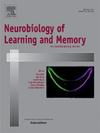dreadd介导的前脾后皮质抑制:对雄性和雌性Long Evans大鼠对物体、位置和物体原位关联的新奇识别的影响
IF 2.2
4区 心理学
Q3 BEHAVIORAL SCIENCES
引用次数: 0
摘要
先前的研究表明,前脾后皮质(aRSC)的嗜离子性谷氨酸受体对短期(1小时)物体就位(OiP)新颖性识别很重要,这表明在OiP测试阶段与新物体定位对的相互作用增强。在这里,雄性和雌性大鼠重复进行三个1小时延迟新颖性识别测试:物体识别(OR),物体定位(OL)和OiP。在行为测试之前,将对照(AAV5-CaMKIIα-mCherry)或活性(AAV5-CaMKIIα-hM4D(Gi)-mCherry)病毒载体双侧注入雄性(8只对照,13只活性)和雌性(8只对照,13只活性)Long Evans大鼠的aRSC,使hM4D激动剂化合物21 (C-21)选择性抑制aRSC神经元。手术恢复后,大鼠在注射生理盐水或C-21 (1.0 mg/kg;实验阶段前45分钟(6次/只大鼠)。对探索时间的分析表明,在不同的阶段、性别或治疗中,总的对象交互时间没有差异。进一步的分析显示,注入活性载体的C-21治疗大鼠在OR测试中降低了新颖性识别,但对OL测试没有影响,无论性别如何。有趣的是,在OiP识别测试阶段,C-21也降低了对新颖性的识别,这种效果仅在注入活性载体的雄性大鼠中观察到。研究结果强调了aRSC神经元在支持新颖性识别方面的细微影响,这种影响因性别和刺激类型而异。本文章由计算机程序翻译,如有差异,请以英文原文为准。
DREADD-mediated inhibition of anterior retrosplenial cortex: Effects on novelty recognition of objects, locations, and object-in-place associations in male and female Long Evans rats
Previous research suggests ionotropic glutamate receptors in anterior retrosplenial cortex (aRSC) are important for short-term (1-hour) object-in-place (OiP) novelty recognition, indicated by enhanced interaction with novel object-location pairs during OiP test phases. Here, male and female rats were repeatedly tested in three 1-hour delay novelty recognition tests: object recognition (OR), object location (OL), and OiP. Prior to behavioral testing, control (AAV5-CaMKIIα-mCherry) or active (AAV5-CaMKIIα-hM4D(Gi)-mCherry) viral vectors were bilaterally infused into the aRSC of male (8 control, 13 active) and female (8 control, 13 active) Long Evans rats, enabling selective inhibition of aRSC neurons with the hM4D agonist Compound 21 (C-21). Following recovery from surgery, rats were repeatedly tested in recognition tests following injection of either saline or C-21 (1.0 mg/kg; i.p.) ∼45-min prior to test phases (6 tests/rat). Analyses of exploration times indicated that total object interaction times did not differ between phase, sex, or treatment. Further analyses revealed that C-21 treatment of rats infused with the active vector reduced novelty recognition in the OR test yet had no influence in the OL test, regardless of sex. Interestingly, C-21 also reduced novelty recognition in OiP recognition test phases, an effect only observed in male rats infused with the active vector. Findings highlight a nuanced influence of aRSC neurons in supporting novelty recognition which varies by sex and type of stimuli assayed.
求助全文
通过发布文献求助,成功后即可免费获取论文全文。
去求助
来源期刊
CiteScore
5.10
自引率
7.40%
发文量
77
审稿时长
12.6 weeks
期刊介绍:
Neurobiology of Learning and Memory publishes articles examining the neurobiological mechanisms underlying learning and memory at all levels of analysis ranging from molecular biology to synaptic and neural plasticity and behavior. We are especially interested in manuscripts that examine the neural circuits and molecular mechanisms underlying learning, memory and plasticity in both experimental animals and human subjects.

 求助内容:
求助内容: 应助结果提醒方式:
应助结果提醒方式:


